
This is Part 3 in my series “Growing Potatoes”. In this post I will provide pictures and information to show you how to plant and grow potatoes. Also see the links to Part 1: Getting Started, Part 2: Choosing Seed Potatoes, and Part 4: Harvesting and Storing Potatoes.
Before I get started, please be informed that I am only a hobby gardener and not a professional, and my information is based on what I have learned through reading and personal experience.
How-To Reference Guide
For your convenience, I have added a little how-to guide for easy reference in the very beginning of this post, and more detailed information beneath. For metric measurements, see Conversions to Metric in the top menu bar.
1. Choose certified seed potatoes.
2. Plant whole, small seed potatoes, or cut into 2-inch pieces with at least 1-2 eyes in each.
3. Let cut pieces sit for 1 day after cutting until a thin callous forms on the cut sides.
4. Plant in spring as soon as soil can be worked, or any time after that; but allow enough time for maturing before winter.
5. Dig a 6 inch deep trench for planting, or a 6 inch deep hole for each seed potato.
6. Plant potatoes or pieces 1 1/2 foot apart, sprouts up, and around 2-3 feet between rows.
7. Cover with 4 inches of dirt.
8. When sprouts emerge, cover with up to 4 more inches of soil but leave a few inches of foliage exposed.
9. When green stems emerge again and are 8 inches tall, cover / hill with dirt half way up the stems, up against the plants.
10. After 2-3 more weeks, repeat, and hill dirt half way up the stems again.
11. Add 1-2 inches of soil every week or two until blooms appear, then hill as needed just to keep potatoes covered.
12. Harvest anytime 2-3 weeks after blooming is done as soon as potatoes have formed, until as late as when the plants have died back in the fall, but before the ground freezes. Tubers will continue to grow in size until plants die back.
13. Rotate to grow in the same area only every 3-4 years to prevent disease.
Planting Potatoes
OK, so here are the details to help you along! This is the fun part!! (Oh, and harvesting too, of course!) As you can see in these pictures, we were working on putting in a fence at the same time.
To plant, dig a 6 inch trench, or dig a hole for each potato.
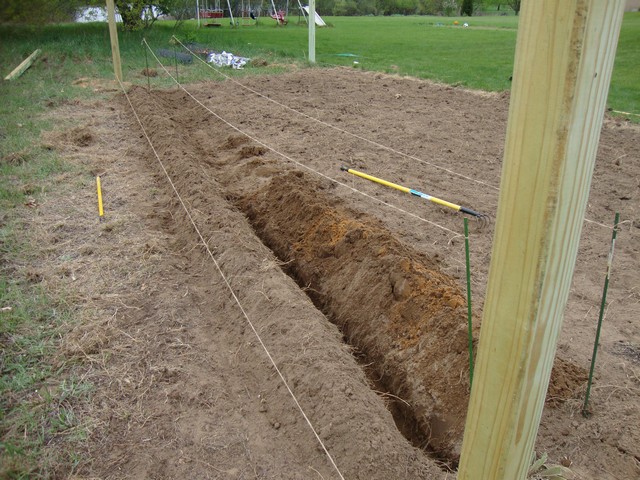
Rows should be around to 2 – 3 feet apart; I tried 2 ft. between my rows last year, and though the potatoes yielded fine for the most part, the rows were too close for me to work comfortably around them and to hill properly. I will space them a full 3 ft. apart next time, just for convenience. During my first year of planting potatoes (which is the source of most of the pictures in this post; the fence isn’t even fully in yet!), I dug a long, 8 in deep trench, which was a pretty tedious job. I tied string to stakes on either side to use as a guide for where to dig in order to get a nice, straight row. The following year I just dug a hole for each potato; laid them down sprouts up and covered with a few inches of dirt. That’s what I did this year as well.
I like to plant them approximately 1½ feet apart in the rows, though they can be as close as 15 inches if you wish. Any closer than that, and you may end up with small potatoes; more than 2 feet apart is really not necessary.
Plant the potatoes eyes / sprouts up, and cover with 3-4 inches of soil.
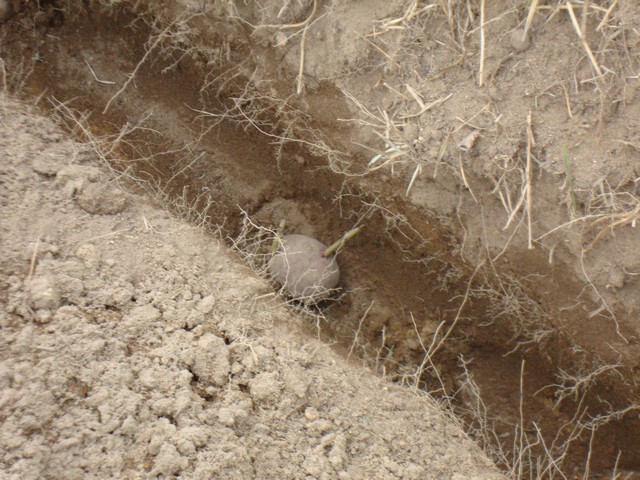
Growing Potatoes
You can often see the soil cracking a bit on the surface just before sprouts emerge. They are quite thick and strong right from the get-go. When sprouts emerge, fill up to 3-4 more inches of soil but don’t cover completely. (This is my personal opinion; more on this below.)
See row on the right in the next picture. The left row is a row of carrots. In my potato row I stuck down some sticks (skewers) to note where the original potatoes were planted in order to keep track of each plant and see how the different varieties were coming along.
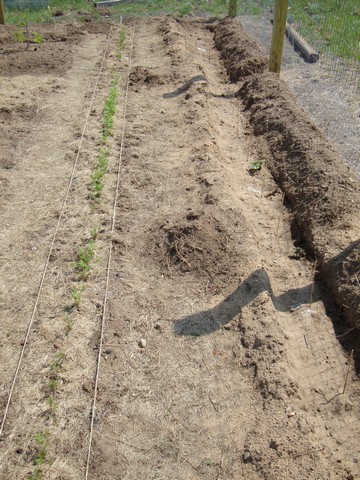
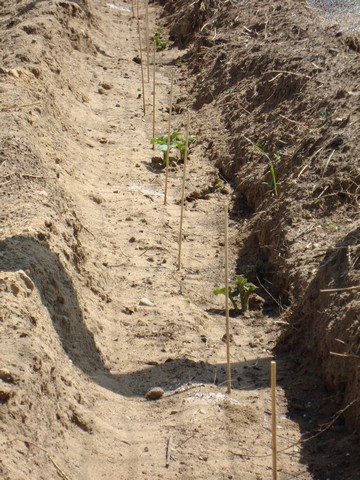
Let the plants grow around 8 inches tall or so. Then hill half way up stem.
Hilling is when you pull up dirt from around the potato plants to create mounds along the stems. This is done in order to protect the potatoes, which grow out from the stems of the potato plants, from light so they don’t turn green. Some people use straw instead of dirt, which would be less work, no doubt!
Just how to go about hilling after the first sprouts show their green little faces is a matter of opinion; some say to completely cover the plants right away when they first appear, and others say to allow some growth first before hilling up against them. I think the latter is safer, and the whole point is to allow potatoes to form alongside the stems, and to keep the potatoes from getting exposed to light. But it is too early for potatoes to be forming anyway, so waiting a while seems like a safer way to go.
Here’s my own experience and why I now go the safer route: At very early stages they may tolerate being covered completely, but in a very short while you will probably kill the plants if you do. One year that did happen to me!! I had waited just a little bit too long (too busy) and killed almost every plant. Yikes! So I feel it’s safer to always let them grow a little bit before adding dirt, and allow some foliage to be exposed to light.
I hilled a lot during my first year of potato planting, being very diligent indeed. After initially having planted 8 in. deep in a trench, it took a lot of hard digging to get them out of there. The following year I didn’t plant quite as deeply, and I didn’t hill quite as much. I still got a nice harvest and no potatoes were exposed to light. It was also much easier to harvest.
Next are a couple of pictures from when I just dug a 6 inch hole for each potato and not as deep as when I dug the trench, then I just covered the entire hole instead of only half way. I can’t say there was much of a difference, so this was just easier for me. These pictures show how I hill mine, using a hoe or cultivating fork. In the beginning it’s flat all around, but there will soon be mounds around each plant. These plants emerged and grew a bit before I got around to hilling.

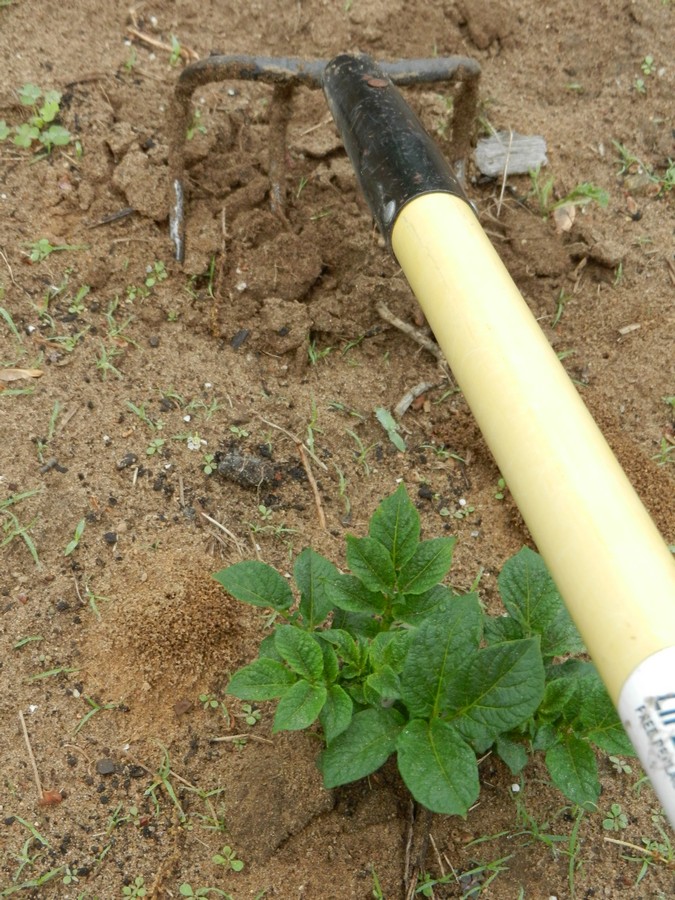
Just be careful not to disturb the plant itself!
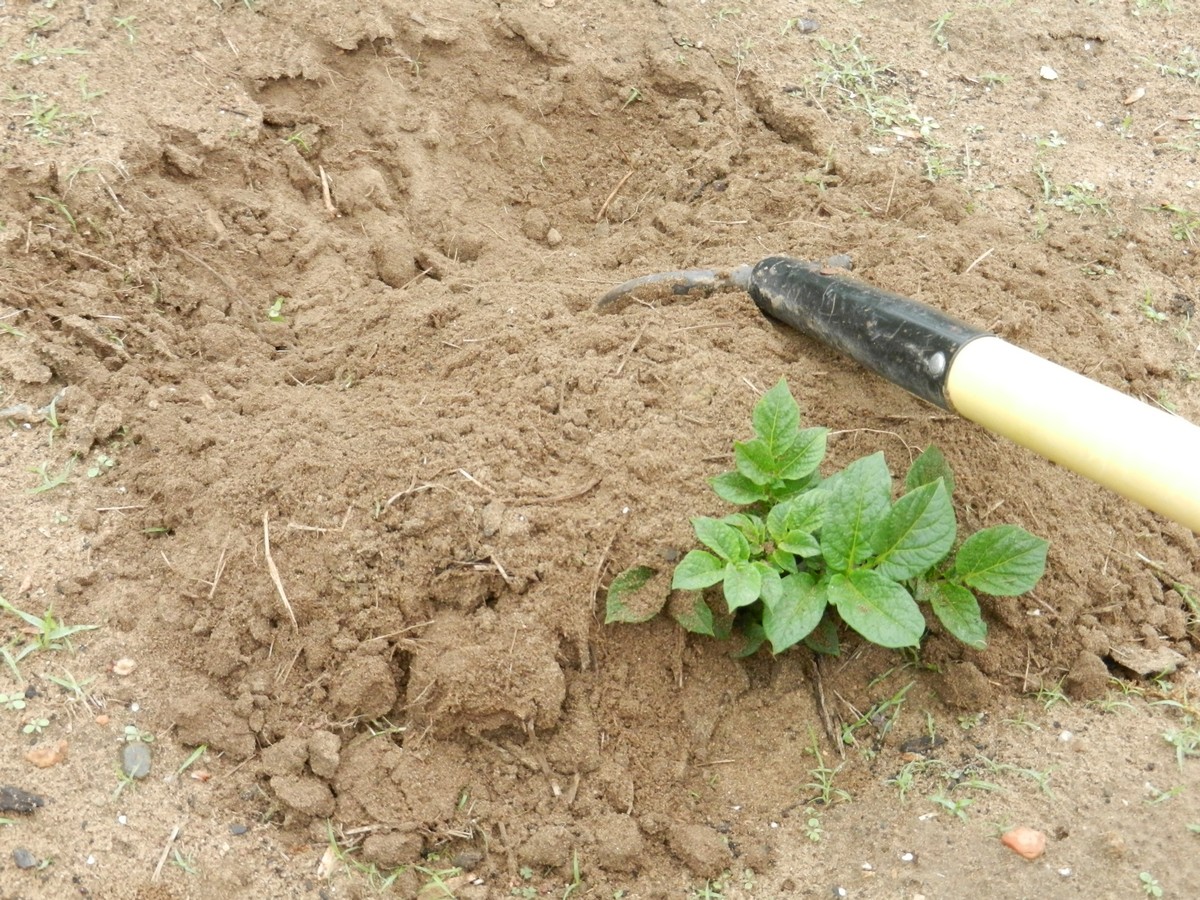
Here they are nearly covered, and they will soon grow right up again, so then you’ll dig some more. (Don’t cover quite as much as what I did in these pictures; these pictures were taken before the year I experienced my big loss, so I now consider it too risky to cover as much as below.)
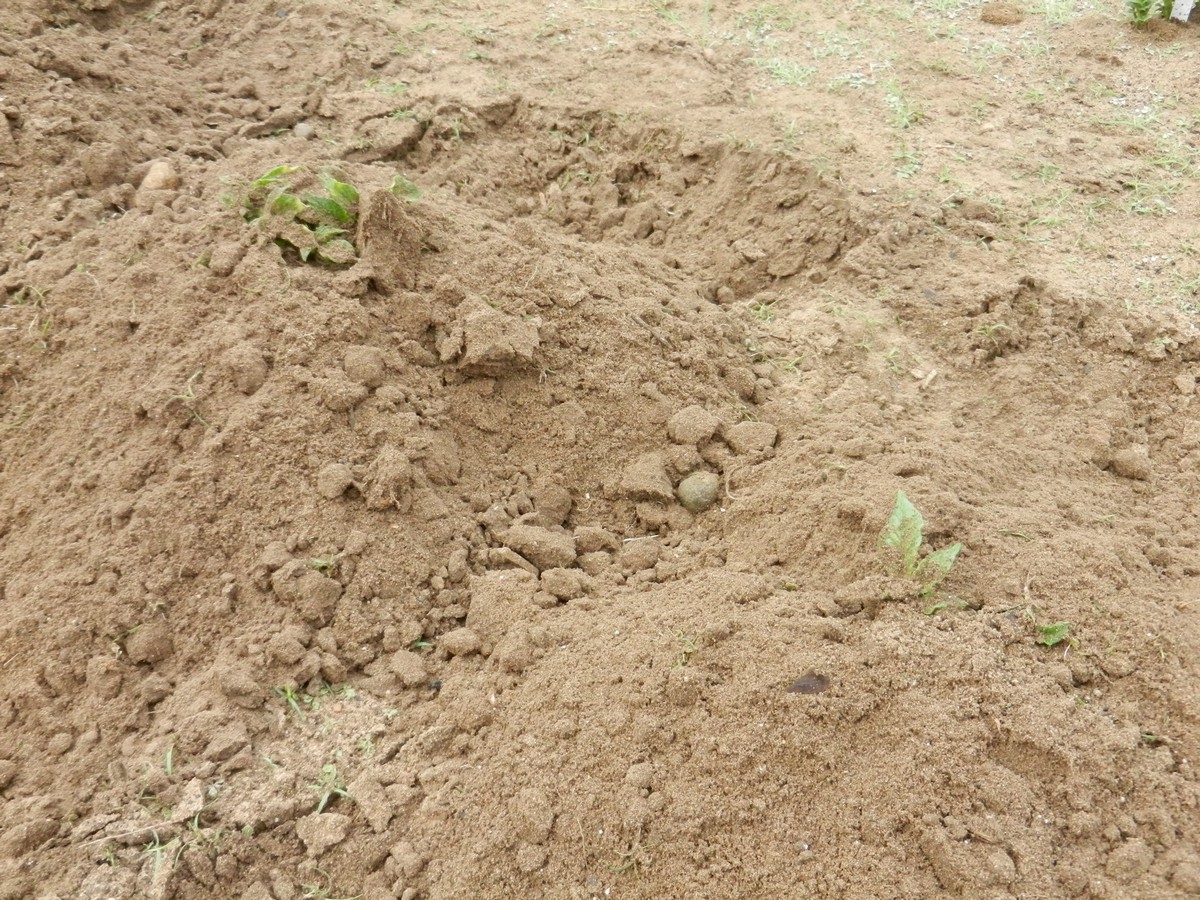
The tubers (potatoes) will grow out from the stem and need to be covered to be protected from light. Keep on adding more layers of soil every week or two, 1-2 in. at a time as needed. In later stages you can check to see if you see tubers forming toward the top; if so, add more dirt as light will make them turn green. This green layer is toxic, so you’ll want to avoid that. You can see some green on this potato that I was peeling for supper the other night (supermarket potato):
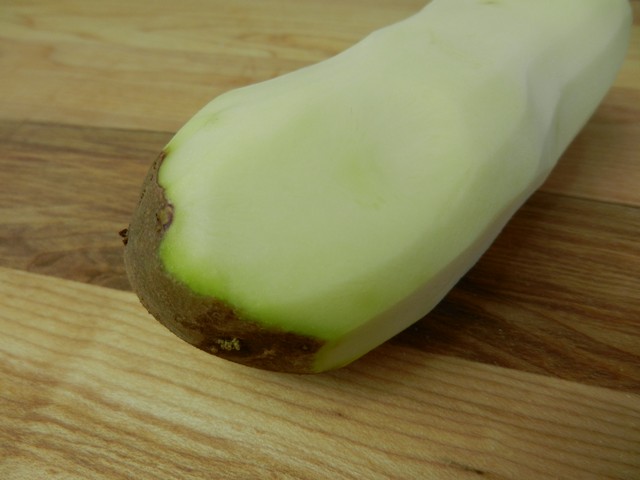
In the following picture, with a potato row on the left (carrots on the right), you can see that the hills of dirt that originally was on either side of the trench have been completely leveled out as it gradually was used for hilling. Instead this dirt will form a single row of raised dirt in the middle where the trench used to be. The dirt has been packed up along the stems of each plant.

The plants are growing and developing flowers now, and a couple of the plants are also starting to show some distress. You can see some leaves here and there curling somewhat. If your plants do not flower, don’t be alarmed. For some reason, not all plants will produce flowers, especially in warm climates such as zone 8. Since you won’t be needing the flowers anyway, there really isn’t a problem and they still produce potatoes.
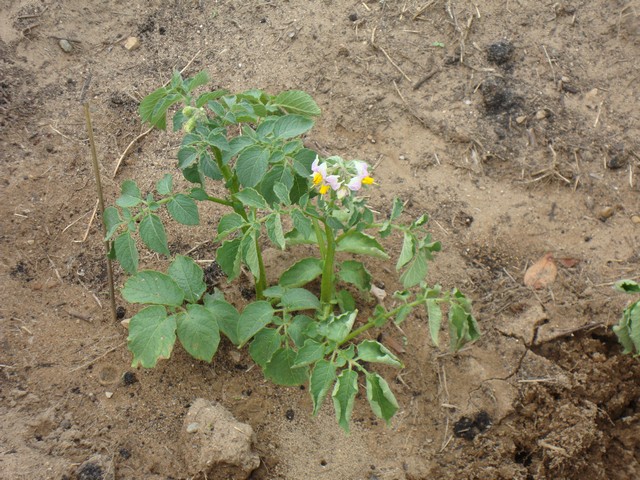
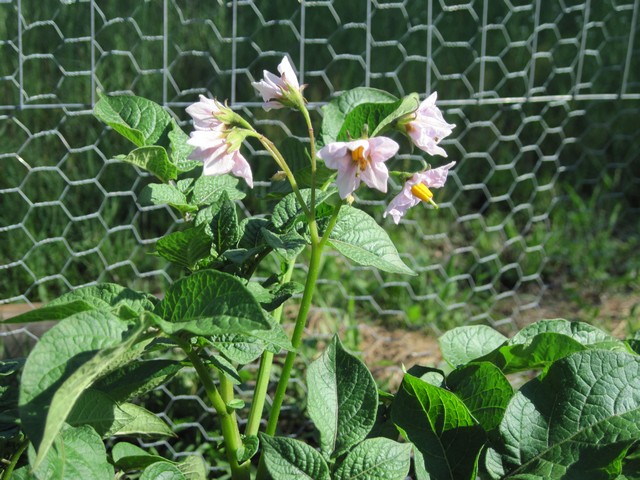
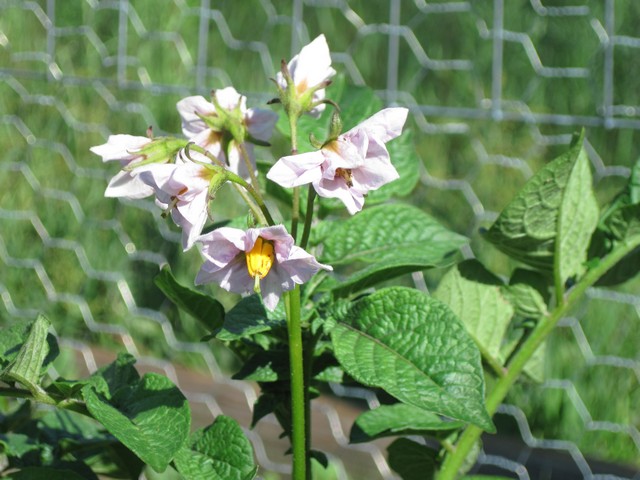
Fertilizing
Though potatoes enjoy compost, don’t worry about it if you don’t have any. There is no need for very fertile soil as they are not picky plants at all, and will usually perform fairly well in poor soil as well as soil containing compost. Do not use a lot of fertilizer, on the other hand, especially nitrogen, as it will result in lots of plant growth but very few tubers. All plants need some nutrition, however, especially if the soil has become depleted after years of growing vegetables. Compost is best, although a balanced organic or granular synthetic fertilizer (such as 12-12-12 or so) can also be used. Loose, well-drained soil helps to increase yield. Slightly acidic soil is preferred, so I like to add coffee grounds to help bring down the PH level a little bit. Some coffee shops, like Starbucks, will often fill up bags of used coffee grounds and give it to gardeners for free, for composting purposes. So this is an advantageous way to recycle coffee grounds that would otherwise bee thrown in the dumpster. Why put it in the dump if it can feed your plants?
Watering
Watering regularly will produce a better crop; however, potatoes do tolerate dryer conditions better than many other vegetable plants. It is especially important, however, to water them during blooming and shortly after, as this is when the potatoes are formed, increasing the need for water. It is important to know that the soil should never be water logged at any stage, or the potatoes will easily rot. Also, try to water early in the day so that the plants have plenty of time to dry off before evening, to prevent fungal diseases. It is hard to keep potato plants 100% disease free, and so far I have not found it to be necessary either.
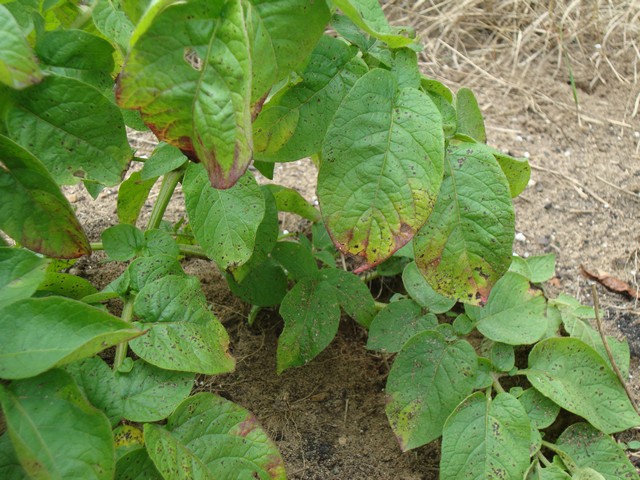
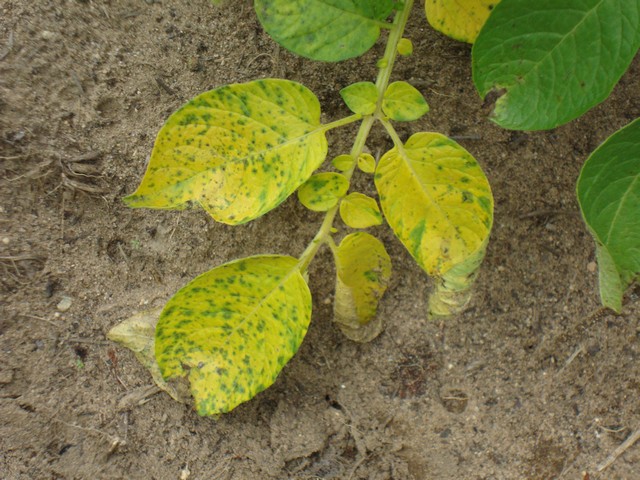
Later Stages
Soon after the flowers are done blooming, the plants will start to yellow and whither, and eventually turn brown and die completely. This natural and normal process is to be expected, and is called “dying off”. The potatoes are simply done growing and no longer need the green plant material to sustain them. The potatoes can be harvested any time now, unless they will be in storage. More on these things in my next post, Part 4: Harvesting and Storing Potatoes.
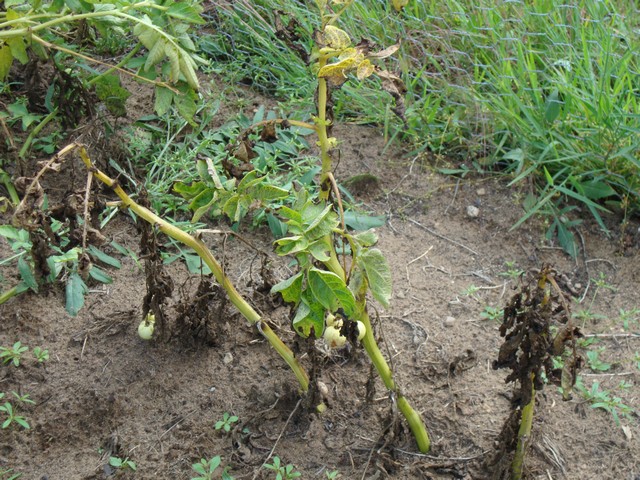
When the plants start to yellow and die back, you should stop watering altogether, as the potatoes really are done growing and are working on developing a thick, tough, protective skin, which will be helpful for storage. During this stage, they do tolerate some rain, but they do not actually need it, and it’s best to keep it to a minimum to prevent rotting or sprouting of the tubers you were planning to eat. If you are planning on using them right away, you don’t have to worry about developing a thicker skin.
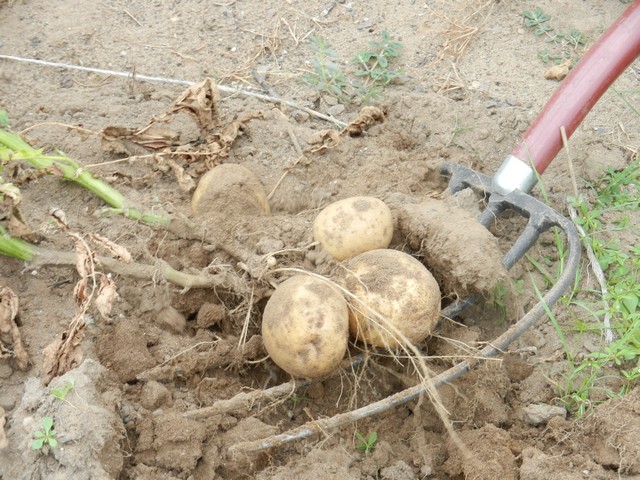
I hope you’ll enjoy growing potatoes as much as I do! There is nothing like bringing in fresh produce from your own garden, after working and tending to your plants, and watching them grow until it’s time for harvest! Since potatoes grow under ground, you get to go on a treasure hunt when harvest time comes around! Check out my next post on how to harvest and store potatoes!
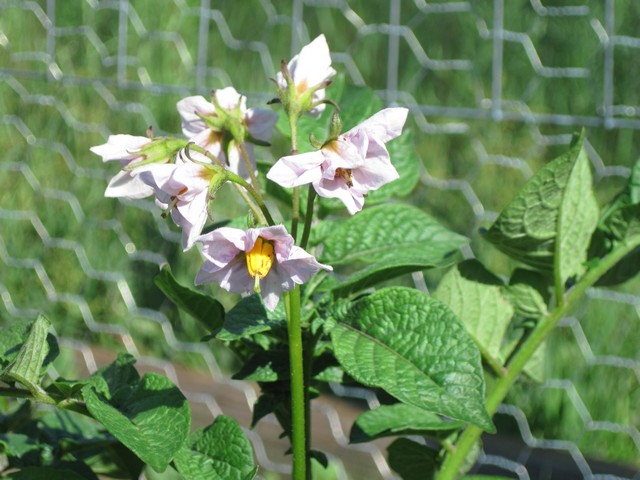

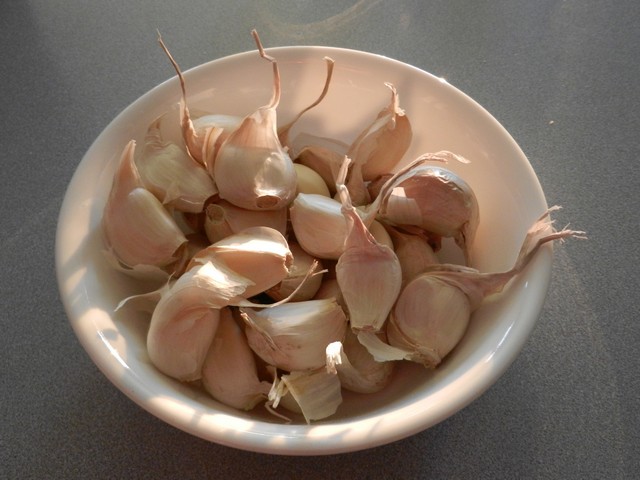
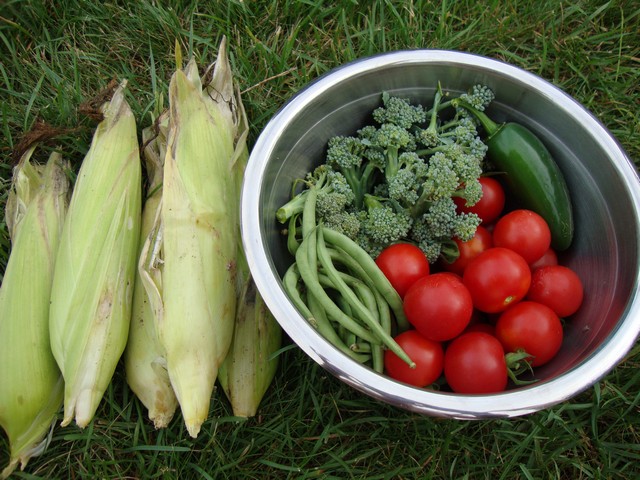

Hi! Where we live there are too many trees for a regular garden. I tried but it was too much work. So we put in a more like container garden. Two, 4×4 square containers for most of the plants my daughter wanted to try. For the potatoes though I used a Very large flower pot and planted three potatoes in the bottom dirt and as they grew kept filling in the pot. They are just starting to die back a bit and some are still flowering. My only concern has been about too much rain and rot. But I think they are alright. If after the plants die back and I cover the pots could I harden them in the pots? Harvesting should be easy because i’ll just tip the pot over on newspapers. I love your site and all the pictures!!
Thanks for the compliments! You can definitely harden them right in the pot, as long as it doesn’t get so cold that the soil freezes right through. Also, rot can be a problem if the soil remains soggy.
So glad I found this, been doing it all wrong. Next year my potatoes are going to be great. Thanks so much for the easy to follow instructions I think I can still save this years crop with the info I learned. Have a blessed day.
I’m glad you found my post helpful! Thank you for commenting, and I wish you a bountiful harvest next time around, or hopefully even this time! God bless you and your hard work!
Thank You!
Now I Know The method!
You saved me Drama! Lol ?
Good deal!! Less is more when it comes to drama! 😀
Thanks for your nice site. I have ssearched endlessly for answer: When “Hilling” (we are using straw, short on extra soil” ) Does one pack so the ‘stems’ are covered in the hill, as one brings them up so they don’t flop. Or does one just let them flop covering the leaf loaded stem. Thus the formation of potatoes grow from the limbs on the main stem.
In my search I don’t get an clarification.. Your photos seem to indicate the latter in my ? remark. Okay to cover all of the foliage? Blossoms haven’t happened and we would like to keep mounding….. more potatoes hopefully.
Grateful!! for clarification.
I will try to help, let me know if I seem to not have understood. Just so it’s clear though, I am only a hobby gardener and not a professional, and my information is based on what I have learned through reading and experiencing. But hopefully I can help clarify.
In my experience you can let them flop, that’s OK. In dirt, the weight of the hills will hold the plants upright for a while, until you stop hilling, then some branches will continue to grow and start to flop. Potato plants tolerate growing out along the ground. I have some growing right now in spots they were not intended (small ones that I missed during harvest last year), growing in the middle of other vegetables. I couldn’t bring myself to remove them, but hilling is difficult there, so they’re just sprawling along the ground and doing great. I will have to add dirt eventually. But the plants do not need to be staked by the hills, if that’s part of what you wonder about. So in a sense, when using light weight straw that cannot support the weight of a big plant, that could potentially mean that a straw “hill” is sprawling along with the plant. Although it is best if there is a layer of straw between the soil and the foliage to protect from disease caused by spores in the soil. I currently have grass clippings as mulch, so that helps too.
Since your plants have not flowered yet and you’d like to add more straw, I’d say definitely do so. Here’s an article that tells you to add more straw every time the plant adds on 6-8 inches until the plant flowers: http://www.agardenforthehouse.com/2010/06/hill-your-potatoes-for-an-increased-harvest/
So yes, you hill to cover up part of the main stem, but definitely not all of the foliage on the entire plant or you could kill it completely. Some of the plant needs to be able to get light and sun for photosynthesis. Personally I hill until there’s a good pile around the main stem, then I let it be. I add more later if I see potatoes starting to form toward the surface. Whether you get more potatoes if you continue to mound more and more, is a bit unclear to me. I have not seen more potatoes under the biggest piles of dirt in my own garden; sometimes more dirt just meant more / deeper digging for me. I am also learning as I’m going and as I gain more experience, so it could be that there are better ways than what I’m currently doing.
I hope this helps! Please let me know if something is unclear. I know it’s a pain to look and look for answers and not being able to find them! That’s actually what prompted me to write this article; my plants looked like they were dying but I couldn’t figure out whether this was what they were supposed to look like in the beginning of that normal process. So were they dying because something was wrong, or because they had reached that point in a normal development? Nobody talked about that and there were no pictures to show that process, only pictures to show you what a dead plant looked like. So here I am! And now I know! Haha!